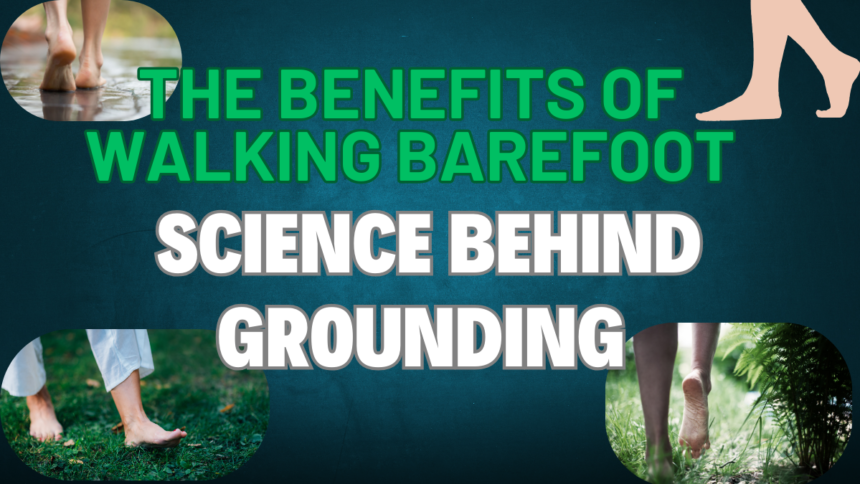Walking Barefoot: Science Behind Grounding
Have you ever kicked off your shoes and felt an instant sense of relief as your feet touched the grass, sand, or soil? That simple act isn’t just refreshing—it might be one of the healthiest habits you’re not thinking about. Walking barefoot, also known as “grounding” or “earthing,” has been practiced for centuries, but modern science is now uncovering its surprising benefits.
From reducing inflammation to improving sleep, the connection between our bodies and the Earth’s natural energy is more powerful than we realize. In this post, we’ll explore the science behind grounding, its health benefits, and practical tips for incorporating barefoot walking into your daily routine.
What Is Grounding? The Science Behind Walking Barefoot
Grounding is the practice of connecting directly with the Earth’s surface—whether it’s grass, sand, dirt, or even concrete (to a lesser extent). The idea is that the Earth carries a subtle electric charge, and when we make direct contact, our bodies absorb electrons that help neutralize free radicals and reduce inflammation.
How Does Grounding Work?
- The Earth has a negative ionic charge due to its natural electrical field.
- When we walk barefoot, electrons transfer from the ground into our bodies.
- These electrons act as natural antioxidants, helping to combat oxidative stress and inflammation.
A study published in the Journal of Environmental and Public Health found that grounding can improve sleep, reduce pain, and even lower stress by normalizing cortisol levels.
Top Health Benefits of Walking Barefoot
1. Reduces Inflammation & Pain
Chronic inflammation is linked to many diseases, including arthritis and heart conditions. Grounding has been shown to reduce inflammation by neutralizing free radicals in the body.
- A 2015 study in The Journal of Inflammation Research found that grounding significantly reduced markers of inflammation in participants.
- Many people report less joint and muscle pain after regular barefoot walking.
Video Credits
2. Improves Sleep & Reduces Stress
If you struggle with insomnia or restless nights, grounding might help. Walking barefoot (especially in the morning) helps regulate cortisol levels, the hormone responsible for stress.
- Research suggests grounding can improve sleep by aligning the body’s circadian rhythm.
- The calming effect of connecting with nature also reduces anxiety.
3. Enhances Balance & Posture
Wearing shoes all the time weakens the small muscles in our feet. Walking barefoot strengthens these muscles, improving balance and posture.
- Barefoot walking engages more sensory nerves, enhancing proprioception (body awareness).
- This can prevent falls and improve athletic performance.
4. Boosts Circulation & Heart Health
Walking barefoot stimulates pressure points in the feet, which can improve blood flow. Some studies suggest grounding may also help regulate blood pressure.
- A 2013 study in The Journal of Alternative and Complementary Medicine found that grounding improved blood viscosity, reducing the risk of cardiovascular issues.
5. Strengthens Immune Function
Since grounding reduces inflammation and stress, it indirectly supports the immune system. Less chronic stress means a stronger defense against illnesses.
Tips for Safe & Effective Barefoot Walking (Grounding)
Want to try grounding? Here’s how to do it safely and effectively:
1. Start Slowly
If you’re used to wearing shoes all the time, your feet need time to adapt. Begin with 5-10 minutes a day on soft surfaces like grass or sand.
2. Choose the Right Surfaces
- Best for grounding: Grass, sand, soil, natural stone.
- Less effective but still beneficial: Concrete, brick (if unsealed).
- Avoid: Hot pavement, sharp rocks, or polluted areas.
3. Try Morning or Evening Grounding
Early morning dew or evening walks enhance the grounding effect due to higher moisture levels (better conductivity).
4. Combine with Mindfulness
Walking barefoot is a great opportunity to practice mindfulness. Focus on the sensations under your feet—cool grass, warm sand—to deepen relaxation.
5. Use Grounding Indoors (If Needed)
If you can’t go outside, grounding mats or sheets (designed to mimic Earth’s electrons) can be an alternative.
6. Keep Feet Clean & Check for Injuries
After grounding, rinse your feet to remove dirt. If you have cuts or infections, avoid walking barefoot in public areas.
Myths vs. Facts About Grounding
❌ Myth: “Grounding is just a placebo effect.”
✅ Fact: Multiple studies show measurable changes in inflammation, cortisol, and circulation after grounding.
❌ Myth: “You need hours of barefoot walking to see benefits.”
✅ Fact: Even 20-30 minutes a day can make a difference.
❌ Myth: “Only naturalists and hippies do grounding.”
✅ Fact: Athletes, biohackers, and scientists all study grounding for its proven benefits.
Final Thoughts: Should You Walk Barefoot More Often?
Walking barefoot isn’t just a nostalgic childhood memory—it’s a simple, science-backed way to boost your health. Whether you’re looking to reduce stress, improve sleep, or strengthen your feet, grounding is a free and natural therapy available to everyone.
Have you tried grounding? Share your experience in the comments below!


